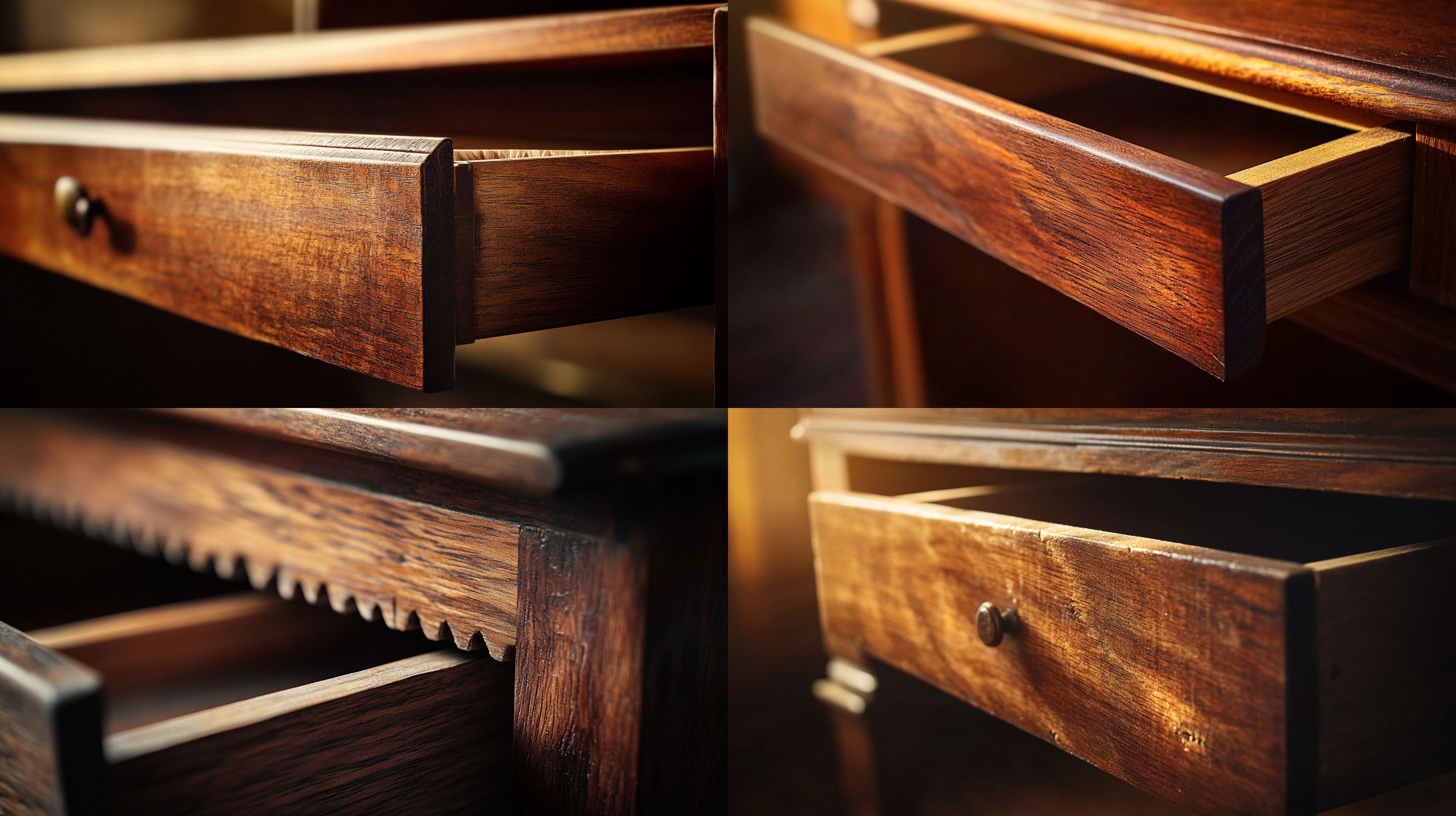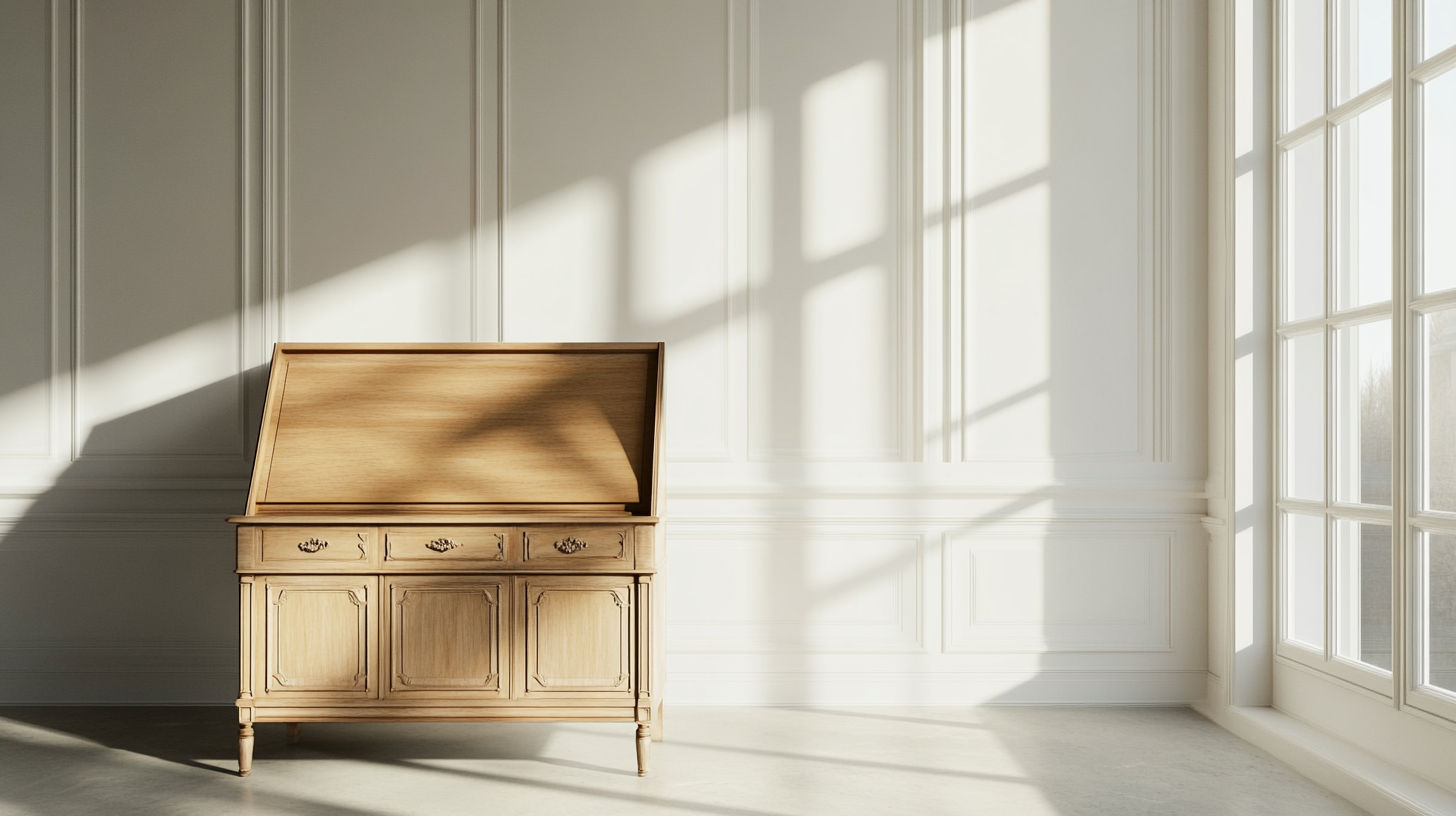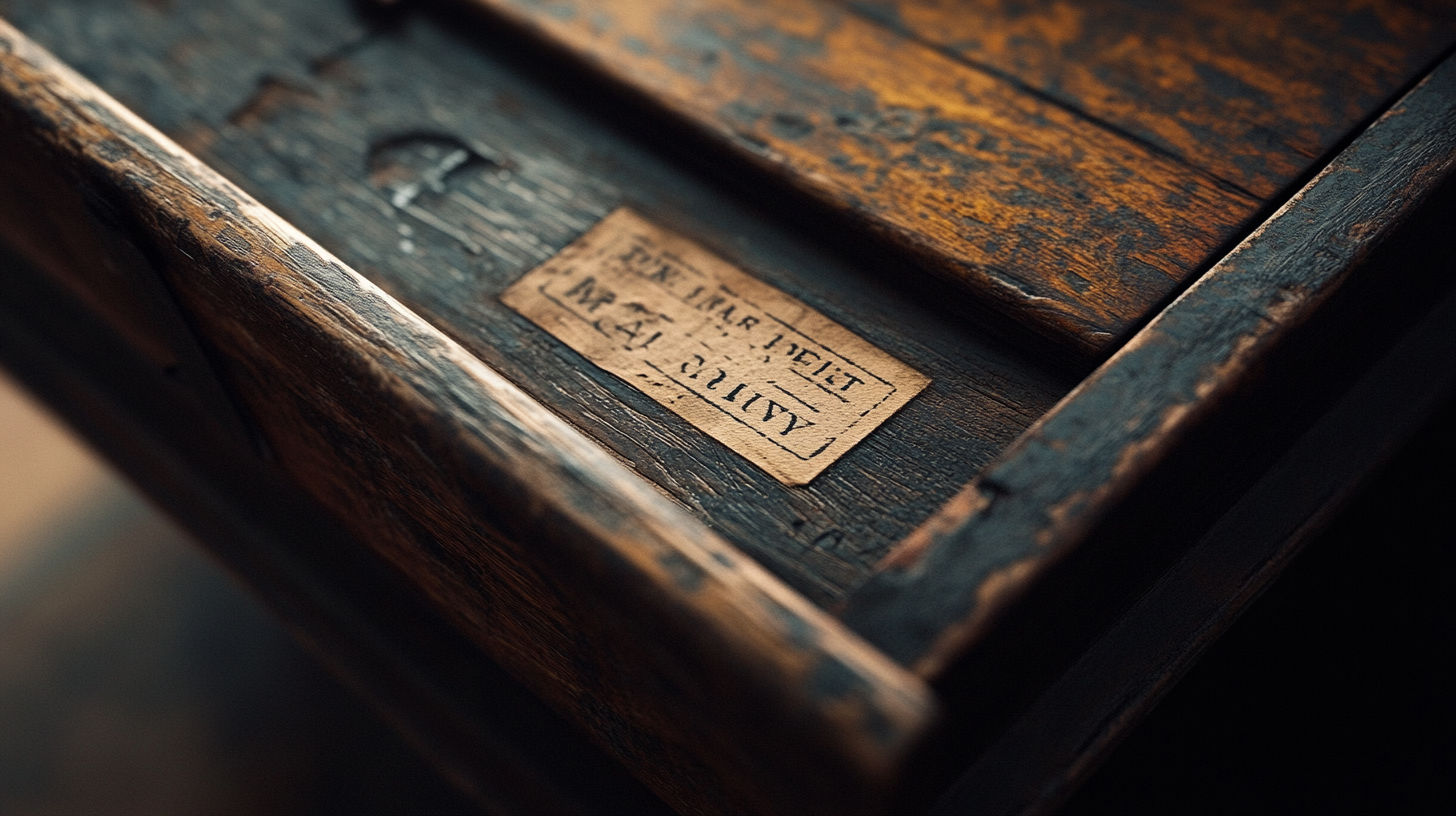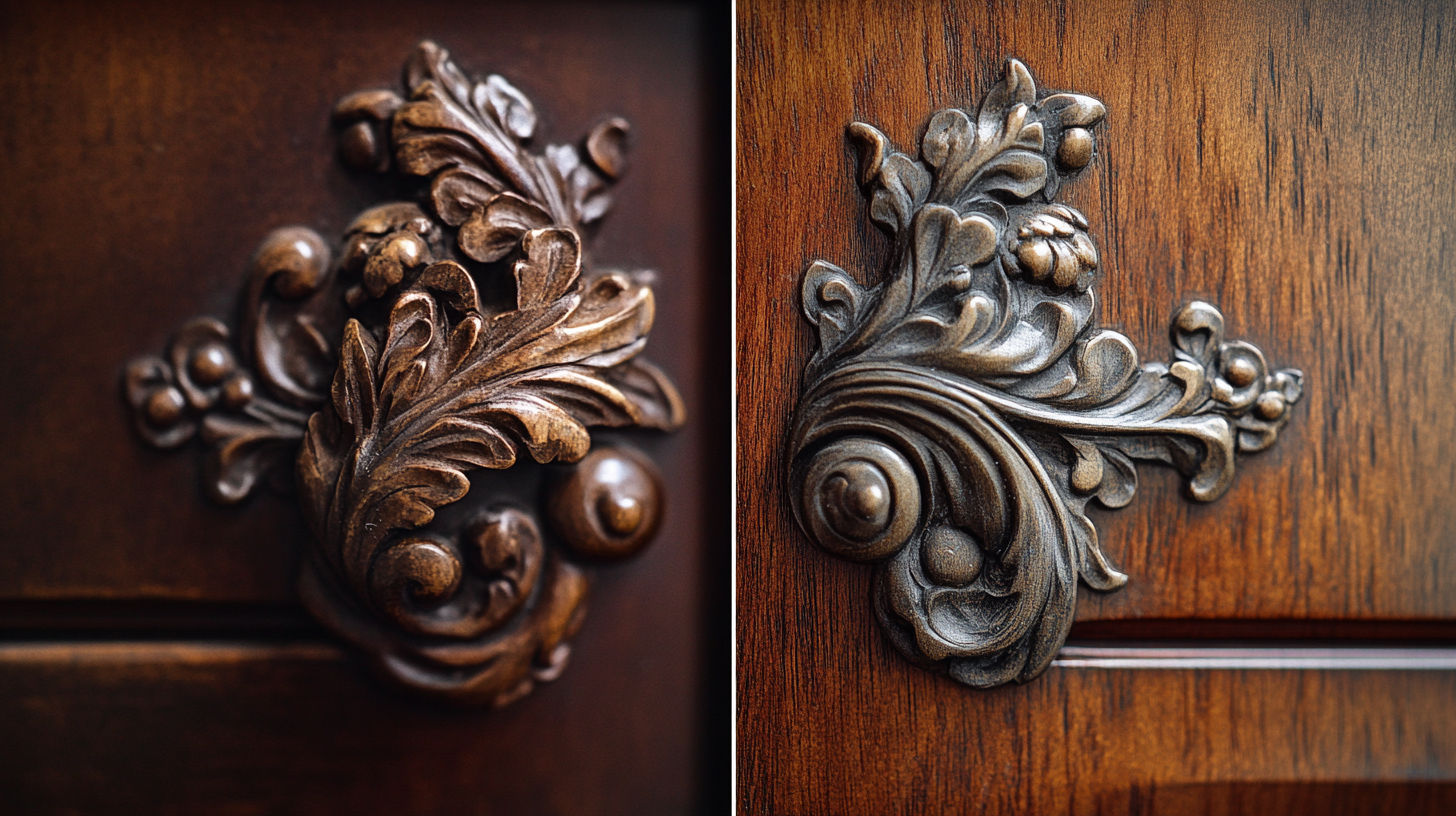Introduction to Antique Secretary Desks

A secretary desk (sometimes called a secrétaire) typically features a drop-front or slant-top writing surface with numerous small drawers, pigeonholes, and compartments hidden behind. Many include drawers or cabinet space below and bookcase or display cabinets above. These functional yet elegant pieces served as central organizational hubs in both homes and businesses throughout history.
Today, collectors and enthusiasts value these pieces not only for their beauty but for their historical significance and craftsmanship. This guide will help you identify authentic antique secretary desks, understand their styles and periods, and recognize the quality indicators that determine their value.
Antique Secretary Desk Key Facts
Understanding Secretary Desk Styles and Periods
Secretary Desk Evolution Through History
Queen Anne & Early Georgian
Early secretary desks featuring slant-front designs, cabriole legs, shell motifs, and simpler interior compartments. Often made from walnut or maple with minimal ornamentation.
Chippendale
More ornate designs with claw-and-ball feet, carved embellishments, and Gothic or Chinese-inspired elements. Mahogany became the predominant wood choice for high-end pieces.
Federal/Hepplewhite/Sheraton
Lighter, more delicate proportions with straight legs, inlay work, and more geometric designs. Features like tambour doors and specialized compartments became more common.
Empire & Victorian Early
Heavier proportions with columns, scrolled elements, and substantial pediments. Often featured darker woods, veneers, and more dramatic ornamentation.
Victorian & Revival Styles
Eclectic designs drawing from multiple historical periods. Often featured machine-cut parts, more elaborate mass-produced ornamentation, and Renaissance or Gothic revival elements.

Key Styles to Recognize
Slant-Front (Fall-Front) Secretary: Popular in the 18th century, featuring a sloped writing surface that opens downward and is supported by pulls or chains. When closed, it resembles a chest of drawers.
Bureau Bookcase/Secretary Bookcase: A two-piece design with a desk section below (usually a chest of drawers with a writing surface) and a bookcase above, often with glass doors. Common in Georgian and Federal periods.
Cylinder Desk: Features a quarter-circle tambour roll-top that slides back to reveal the writing surface and compartments. Popularized during the Federal period.
Drop-Front Secretary: The writing surface folds down vertically (rather than at an angle) and is often supported by brackets or chains. Common in Victorian and later periods.
Secretary Desk with Hutch: A variation with additional display or storage space above, typically separated into a two-piece construction.
Examining Construction and Materials
Wood Types Used in Antique Secretary Desks
The primary woods used in secretary desks varied by period, region, and quality:
- Walnut: Common in Queen Anne and early Georgian pieces (early 18th century)
- Mahogany: Became dominant in mid-to-late 18th century (Chippendale and later)
- Cherry: Popular in American-made pieces, especially Federal period
- Oak: More common in English pieces and some country styles
- Maple: Used in American country pieces and as secondary wood
- Satinwood, Rosewood: Used for veneers and inlays in Federal and later pieces
- Pine, Poplar: Typically used as secondary woods for drawer bottoms and backs
Many high-quality antique secretary desks use different woods for different components—primary wood for visible surfaces and secondary woods for internal structures.

Joinery Methods
The joinery techniques used provide significant clues to a piece’s age and authenticity:
Joinery Authentication Checklist
Hardware Examination
Original hardware can significantly impact a secretary desk’s value and help confirm its period:
- Brass pulls and escutcheons: Styles varied by period; earlier ones tend to be simpler
- Hand-forged hinges: Often irregular with visible hammer marks
- Lock mechanisms: Period-appropriate locks often have hand-filed components
- Wooden drawer runners: Many early pieces have wooden glides rather than metal
Expert Tip: Look for evidence of hardware replacement. While some replacement is common, original hardware significantly enhances value. Carefully examine screw heads—slotted screws handmade before 1850 are typically irregular with off-center slots. Machine-made screws with perfectly centered slots suggest later manufacture or replacement.
Identifying Maker's Marks and Signatures
Where to Look for Maker’s Marks
Craftsmen and manufacturers often left identifying marks in specific locations:
- Inside drawers (particularly upper or lower drawers)
- On the back panels or underside of the desk
- Inside the writing compartment or hidden drawers
- On the bottom of the piece
- Inside cabinet doors

Types of Identification Marks
- Paper labels: Common in American furniture after 1850
- Brand stamps: Burned or stamped manufacturer’s names
- Hand-signed inscriptions: Often pencil or chalk marks by individual craftsmen
- Numbered sequences: Sometimes indicating manufacturing order or model numbers
- Regional stamps: Marks indicating place of manufacture or export stamps
According to auction results from JustAnswer’s antique experts, a marked secretary desk from a known maker can be worth significantly more than an unmarked piece of similar quality.
Notable Manufacturers to Recognize
Several well-known manufacturers produced high-quality secretary desks, and their pieces command premium prices:
- American: Wooton, Herter Brothers, Jelliff, Belter, Phyfe
- English: Chippendale, Sheraton, Hepplewhite, Edwards & Roberts
- European: Boulle, Riesener, Oeben, Roentgen
Important note: If you locate what appears to be a maker’s mark, document it with clear photographs before researching. Online antique forums like Reddit’s r/Antiques can be helpful for identification, as noted in multiple threads where users successfully identified manufacturers from photographs of labels.
Authenticating Age Through Patina and Wear Patterns
Natural Patina Characteristics
Genuine antique secretary desks develop distinctive patina characteristics over decades of use:
- Wood darkening: Natural oxidation causes woods like cherry and mahogany to darken with age
- Color variation: Uneven exposure to light creates subtle variations in color
- Surface texture: Authentic aged surfaces have a subtle luster different from modern finishes
- Finish checking: Fine crackling in the finish (different from damaged or alligatored finishes)
Authentic Wear Patterns
The patterns of wear on a secretary desk should correspond logically to its use over time:
- Worn corners: Especially on the writing surface, desk edges, and feet
- Drawer wear: Smooth, worn areas around drawer pulls and drawer bottoms
- Writing surface wear: The center of the writing area often shows more wear
- Key wear: Area around keyholes often shows wear from regular use
- Interior compartment wear: Less wear than exterior, but consistent with age

Distinguishing Fake Patina
Be alert to these signs of artificially aged furniture:
- Inconsistent aging: Heavy distressing in some areas but not in logical wear points
- Uniform distressing: Authentic wear varies based on use patterns
- Fresh damage made to look old: Look for signs of deliberate distressing
- Artificial darkening: Often too uniform compared to natural aging
- Modern finish over distressing: Authentic finish aging penetrates the wood
According to The Hoarde’s guide to identifying antique furniture, examining patina is one of the most reliable ways to distinguish genuine antiques: “Search for signs of ageing as they can be faked, but it takes considerable skill to produce an authentic-looking patina.”
Value Ranges for Antique Secretary Desks
| Category | Price Range | Notes |
|---|---|---|
| Queen Anne/Early Georgian (1700-1750) | $5,000-$15,000+ | Extremely rare, museum-quality pieces can exceed $25,000 |
| Chippendale Style (1750-1780) | $3,500-$12,000 | Higher values for documented pieces with original hardware |
| Federal/Sheraton/Hepplewhite (1780-1820) | $2,500-$8,000 | Inlaid examples command premium prices |
| Empire/Early Victorian (1820-1850) | $1,500-$4,500 | Fully restored examples with original finish integrity |
| Late Victorian (1850-1900) | $800-$2,500 | More common but still valuable in excellent condition |
| Revival Styles (1880-1920) | $500-$1,500 | Quality varies widely; maker's marks increase value |
Note: Price ranges are approximate and can vary based on condition, rarity, and market demand.
Interior Features and Special Compartments
Characteristic Interior Features
Secretary desks typically include several standard interior elements that evolved over time:
- Pigeonholes: Small compartments for organizing papers and correspondence
- Document slots: Vertical or angled divisions for storing letters and documents
- Small drawers: Tiny drawers for storing writing implements and valuables
- Central door/prospect: Often a focal point with decorative details or a hidden compartment
- Cubbyholes: Open storage areas for frequent access items
Secret Compartments
Many antique secretary desks feature hidden compartments designed to conceal valuables:
- False bottoms in drawers: Sliding panels revealing hidden storage
- Spring-activated compartments: Triggered by pressing specific points
- Hidden drawers: Behind other drawers or panels
- Removable dividers: Revealing concealed storage spaces
- Secret doors within the prospect: Often operated by hidden mechanisms
According to M.S. Rau’s antique desk guide, “The fall-front opening descends to reveal a multitude of features, typically a writing surface, storage shelves and drawers. Often, the bottom section contains additional drawers for storage.”
Expert Tip: When examining a secretary desk, carefully check all interior spaces. Secret compartments may contain historic documents, correspondence, or even valuable items forgotten by previous owners.
Evaluating Condition and Restoration
Assessing Overall Condition
When evaluating an antique secretary desk, consider these condition factors:
- Structural integrity: Check for stability, secure joints, and functioning mechanisms
- Original components: Assess how many original elements remain intact
- Finish condition: Evaluate whether the original finish is present and its condition
- Functionality: Test drawers, doors, writing surfaces, and any mechanical elements
- Damage assessment: Note cracks, water damage, insect damage, or structural issues
Understanding Restoration Impact
Different types of restoration affect value to varying degrees:
- Conservation work: Stabilizing and preserving original elements typically maintains value
- Sympathetic restoration: Period-appropriate repairs using traditional methods slightly impact value
- Hardware replacement: Reproduction hardware moderately decreases value
- Refinishing: Complete stripping and refinishing significantly decreases value
- Structural alterations: Major modifications severely impact authenticity and value
According to Canonbury Antiques’ valuation guide, “Condition is paramount. While minor wear consistent with age is acceptable and even desirable (it adds character and authenticity), significant damage, poor repairs, or missing key elements will drastically reduce value.”
Recognizing Inappropriate Restoration
Be alert to these red flags suggesting inappropriate restoration:
- Modern fasteners: Phillips-head screws or modern nails
- Contemporary glues: Synthetic adhesives instead of hide glue
- Machine-cut replacement parts: Inconsistent with hand-crafted originals
- Anachronistic materials: Non-period woods or hardware
- Excessive uniformity: Overly perfect or machine-made appearance
Restoration Assessment Checklist
Regional Variations and Distinctive Features
English Secretary Desks
English antique secretary desks often feature:
- More formal, symmetrical designs following established style periods
- Mahogany as the predominant wood (after 1730)
- Claw-and-ball feet in earlier periods
- Brass bail or ring pulls with backplates
- More restrained internal organization
American Secretary Desks
American variations typically exhibit:
- Adaptation of European styles with simplified ornamentation
- Greater use of native woods like cherry, maple, and pine
- More variation in regional characteristics (New England vs. Southern)
- Practical designs emphasizing function alongside aesthetics
- Often featuring wooden pulls in rural examples
Continental European Variations
European secretary desks vary by country:
French:
- More elaborate marquetry and veneer work
- Bombe (curved) shapes in some periods
- Ormolu (gilt bronze) mounts
- Sophisticated mechanical features
German:
- Substantial construction with precise joinery
- Complex internal mechanisms
- Use of contrasting light and dark woods
- Regional variations in ornamentation
As noted in the Design Addict forum’s identification thread, many continental European pieces feature distinctive decorative elements like carved figural elements, which can help identify their origin.
Mid-Atlantic and Southern American Features
Regional variations within America include:
- Distinctive interpretations of European styles
- Use of local woods like walnut and yellow pine
- Simplified versions of formal designs
- Regional construction techniques
Understanding these regional characteristics can help narrow down not just the period but the geographic origin of an antique secretary desk, which can significantly impact its collector value and historical importance.
Common Questions About Identifying Antique Secretary Desks
How do I know if my secretary desk is truly antique?
To determine if your secretary desk is genuinely antique (typically considered 100+ years old), examine these key indicators:
1. **Construction techniques**: Look for hand-cut dovetail joints with irregular spacing, mortise and tenon joints, and wooden pegs rather than modern fasteners.
2. **Materials**: Examine the wood types—primary woods like mahogany, walnut, or cherry on visible surfaces with secondary woods like pine or poplar for internal structures.
3. **Hardware**: Original hardware will show appropriate wear and typically features hand-forged elements. Check screw heads—handmade screws before 1850 have irregular, off-center slots.
4. **Patina**: Authentic antiques develop natural patina through oxidation, use, and age. This creates an appearance difficult to fake convincingly.
5. **Maker's marks**: Search for labels, stamps, or signatures inside drawers, on the back, or underneath.
When in doubt, consult with an antique furniture specialist or appraiser who can examine the piece in person.
What era is a secretary desk from?
Secretary desks emerged in the early 18th century and remained popular through the early 20th century. Their specific era can be determined by examining style characteristics:
- **Early 18th century (1700-1750)**: Queen Anne and Early Georgian styles featuring walnut, simple ornamentation, and slant-front designs.
- **Mid-18th century (1750-1780)**: Chippendale influence with more ornate carving, claw-and-ball feet, and predominantly mahogany construction.
- **Late 18th to early 19th century (1780-1820)**: Federal, Hepplewhite, and Sheraton styles with lighter proportions, straight legs, and inlay decoration.
- **19th century (1820-1900)**: Empire, Victorian, and Revival styles featuring heavier proportions, more substantial ornamentation, and varied historical influences.
- **Early 20th century (1900-1930)**: Arts and Crafts, Art Nouveau, and Colonial Revival examples showing respective style characteristics.
The specific design elements, construction techniques, and materials will help narrow down the precise period.
How do I know if my old desk is valuable?
Several factors determine an antique secretary desk's value:
1. **Age and rarity**: Earlier pieces (pre-1830) generally command higher prices, especially if they represent uncommon styles or features.
2. **Maker**: Pieces by known cabinetmakers or manufacturers (with documented attribution or maker's marks) can be significantly more valuable.
3. **Condition**: Original finish, hardware, and minimal restoration dramatically increase value. Even minor repairs can reduce worth if not done sympathetically.
4. **Provenance**: Documented history of ownership, especially connections to historical figures or events, can multiply value.
5. **Quality of craftsmanship**: Exceptional examples with fine inlay, carving, or unusual features command premium prices.
6. **Completeness**: All original components present and functional (keys, interior fittings, hardware).
For a professional valuation, consult a specialized antique furniture appraiser or auction house that deals with period furniture. Provide detailed photographs including the overall piece, construction details, any maker's marks, and condition issues.
What's the difference between a secretary desk and a regular desk?
A secretary desk differs from a regular desk in several key ways:
1. **Writing surface**: Secretary desks feature a hinged or drop-down writing surface rather than a fixed desktop.
2. **Storage organization**: They typically include numerous small compartments, pigeonholes, small drawers, and specialized storage features above the writing surface.
3. **Concealment feature**: The writing surface can be closed to conceal the interior organizational compartments and create a neater appearance when not in use.
4. **Vertical design**: Secretary desks often have a more vertical proportion compared to regular desks, often incorporating bookcase or display cabinets above.
5. **Multi-functionality**: They combine the functions of a desk, filing system, display cabinet, and storage cabinet in a single piece.
These distinctive features made secretary desks particularly popular for homes where space was limited or where a more formal appearance was desired when the desk wasn't in active use.
How can I tell if a secretary desk has been refinished?
Detecting refinishing requires careful examination:
1. **Finish consistency**: Original finishes show variation in wear and color, especially in recessed areas and corners. Refinished pieces often have a more uniform appearance.
2. **Patina depth**: Original finishes penetrate the wood over time, creating depth that refinished surfaces lack.
3. **Finish in hidden areas**: Compare finish color and texture in visible areas versus hidden spaces (under drawers, back panels). Original finishes show more pronounced differences between exposed and unexposed surfaces.
4. **Wood color**: Refinishing often lightens wood color, especially for traditionally dark woods like mahogany or walnut.
5. **Finish type**: Before 1860, shellac and wax finishes predominated. Polyurethane or modern varnishes indicate refinishing.
6. **Dust/finish accumulation**: Examine drawer runners and other friction points. Original pieces show gradual build-up of finish and dust in corners and grooves.
Some refinishing may be acceptable if done sympathetically and if the piece wasn't of museum quality to begin with. However, original finish always commands a premium with collectors.
What should I look for when buying an antique secretary desk?
When purchasing an antique secretary desk, check these crucial elements:
1. **Structural integrity**: Ensure the piece is stable with tight joints. Check that the writing surface operates smoothly and supports weight properly.
2. **Originality**: Assess how much of the piece remains original—hardware, wood components, finish, and internal compartments.
3. **Condition issues**: Look for signs of wood damage (splits, water damage, insect damage) that may be costly to repair.
4. **Repairs and restoration**: Identify any previous restoration and evaluate its quality and appropriateness.
5. **Functionality**: Test all mechanical components—drawers should slide smoothly, doors should close properly, and writing surfaces should operate as intended.
6. **Authenticity indicators**: Examine construction details that confirm the period (appropriate joinery, materials, and craftsmanship).
7. **Provenance**: Request any available documentation about the piece's history, previous owners, or authentication.
8. **Completeness**: Check that all original components are present—interior fittings, hardware, feet, and architectural elements.
Take your time with the examination and, when possible, bring an expert or experienced collector with you to help evaluate the piece before purchasing.
How can I determine the style of my antique secretary desk?
To determine your secretary desk's style:
1. **Identify key design elements**:
- **Queen Anne**: Cabriole legs, pad or trifid feet, minimal ornamentation, curved lines
- **Chippendale**: More ornate carving, claw-and-ball feet, Gothic or Chinese influences
- **Federal/Hepplewhite/Sheraton**: Straight legs, shield-back elements, inlay work, lighter proportions
- **Empire**: Columns, bold scrolls, animal-paw feet, substantial proportions
- **Victorian**: Eclectic ornamentation, often combining multiple historical influences
2. **Examine proportions**: Earlier styles tend to be more delicate compared to later Victorian examples.
3. **Look at hardware**: Each period features distinctive hardware styles—from simple drops to ornate bail pulls.
4. **Check construction details**: Federal pieces often feature inlay, while Victorian pieces may show more machine-made elements.
5. **Research similar examples**: Compare your desk to documented examples in museum collections or reference books.
6. **Consider regional variations**: American interpretations of European styles often show simpler ornamentation or regional adaptations.
Websites like the [Metropolitan Museum of Art](https://www.metmuseum.org/art/collection/search#!?q=secretary%20desk&perPage=20&sortBy=Relevance&offset=0&pageSize=0) and auction house archives like [Sotheby's](https://www.sothebys.com) or [Christie's](https://www.christies.com) provide excellent reference examples with detailed descriptions.
Expert Resources for Further Research
External Resources for Antique Secretary Desk Identification
M.S. Rau Antique Desk Guide
Comprehensive guide to identifying antique desk styles with detailed information about secretary desks and their historical evolution.
The Hoarde: How to Tell if Furniture is Antique
Practical guidance on authenticating antique furniture with specific sections on examining construction and identifying genuine patina.
Invaluable: Guide to Antique Desks
Detailed resource covering antique desk identification, including secretary desks, with information on craftsmanship indicators and market values.
LoveToKnow: Antique Desk Styles
Illustrated guide to identifying various antique desk styles with specific information about secretary desks and their distinguishing features.
Canonbury Antiques: Desk Valuation Guide
Comprehensive guide to valuing antique desks with detailed information about factors affecting value and market trends.
Reddit r/Antiques Community
Active community where experts and collectors help identify antique furniture, including numerous threads about secretary desk identification.
Metropolitan Museum of Art Collection
Museum database featuring authenticated antique secretary desks with detailed descriptions, provenance, and high-quality images for reference.
Antiques Board Forum
Specialized forum with expert discussions about antique furniture identification, including detailed threads about secretary desk authentication.
Conclusion: Becoming an Informed Collector
Remember that authentication is often a cumulative process—no single feature definitively proves a piece’s age, but the combination of appropriate construction techniques, materials, design elements, and wear patterns builds a convincing case for authenticity. When in doubt, consult with experienced dealers, auction house specialists, or professional appraisers who can examine the piece in person.
Whether you’re a collector, dealer, or simply an owner of a treasured family piece, the journey of discovering your secretary desk’s history adds to its significance and helps preserve important information for future generations. By sharing what you learn about your piece’s history, you contribute to the broader understanding of furniture craftsmanship and design evolution.
The enduring appeal of antique secretary desks lies not just in their beauty and craftsmanship but in their connection to the past—each desk tells a story about the era in which it was created, the craftsmen who built it, and the people who used it over generations. Preserving these pieces and the knowledge about them ensures this tangible connection to history continues for generations to come.
